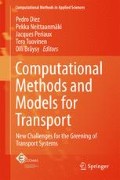Abstract
Crosswind flow over high speed trains can pose serious safety concerns for rail transport. Methodologies for evaluating the aerodynamic forces exerted on the train include full-scale measurements, physical modeling using wind-tunnel experiments and numerical modeling using computational fluid mechanics (CFD). Although CFD presents the most cost-effective approach, it faces severe uncertainties in the predicted forces, most of which are related to the turbulence modeling technique employed. In here we investigate the influence of various turbulence modeling approaches on crosswind flow simulations and calculated force coefficients. In particular, we perform URANS, LES and DDES simulations utilizing the DLR Next Generation Train 2 model geometry. Particular emphasis is laid on simulating a wind angle of 30 degrees and Reynolds number of 225,000 for which validation data is provided by wind tunnel measurements. We confirm that a major vortex system on the leeward side of the train develops, which mainly drives the overturning force and moment of the train. The lift force is determined mainly by the underbody flow, which is characterized by unsteady vortex shedding. Due to its dual ability to properly model the roof boundary layer on the one hand and to resolve small-scale turbulent eddies in the underfloor region on the other, the DDES approach is found to give the most accurate force predictions. LES overpredicts the overturning force and moment, while URANS overpredicts the lift force.
Access this chapter
Tax calculation will be finalised at checkout
Purchases are for personal use only
References
Baker CJ (2003) Some complex applications of the wind loading chain. J Wind Eng Ind Aerodyn 91(12):1791–1811
Baker CJ, Jones J, Lopez-Calleja F, Munday J (2004) Measurements of the cross wind forces on trains. J Wind Eng Ind Aerodyn 92(7):547–563
Bürkle D, Winter J (2013) Forschen für den Zug der Zukunft. http://www.dlr.de/dlr/en/desktopdefault.aspx/tabid-10467/740_read-916/gallery/2043/740_read-916/
Chiu TW, Squire LC (1992) An experimental study of the flow over a train in a crosswind at large yaw angles up to 90. J Wind Eng Ind Aerodyn 45(1):47–74
Copley JM (1987) The three-dimensional flow around railway trains. J Wind Eng Ind Aerodyn 26(1):21–52
Diedrichs B (2003) On computational fluid dynamics modelling of crosswind effects for high-speed rolling stock. Proc Inst Mech Eng Part F J Rail Rapid Transit 217(3):203–226
Ferziger JH, Peric M (2012) Computational methods for fluid dynamics. Springer Science & Business Media, Berlin
Ferziger JH, Peric M, Leonard A (1997) Computational methods for fluid dynamics. Phys Today 50:80
Fragner M, Weinman K, Deiterding R, Fey U, Wagner C (2014) Numerical and experimental studies of train geometries subject to cross winds. Civil-Comp Press, Stirlingshire, UK
Haff J, Richard J, Fey U, Kowalski T, Loose S, Wagner C (2012) Wind tunnel experiments with a high-speed train model subject to cross wind conditions. In: Proceedings of the first international conference on railway technology: research, development and maintenance. Civil-Comp Press, Stirlingshire, Scotland
Hemida H, Krajnović S (2008) LES study of the influence of a train-nose shape on the flow structures under cross-wind conditions. J Fluids Eng 130(9):091101
Hemida H, Krajnović S (2009) Exploring flow structures around a simplified ICE2 train subjected to a 30 side wind using LES. Eng Appl Comput Fluid Mech 3(1):28–41
Hemida H, Baker C (2010) Large-eddy simulation of the flow around a freight wagon subjected to a crosswind. Comput Fluids 39(10):1944–1956
Hemida H, Krajnović S (2010) LES study of the influence of the nose shape and yaw angles on flow structures around trains. J Wind Eng Ind Aerodyn 98(1):34–46
Jasak H (1996) Error analysis and estimation for finite volume method with applications to fluid flow. Ph.D. thesis, Imperial College London
Khier W, Breuer M, Durst F (2000) Flow structure around trains under side wind conditions: a numerical study. Comput Fluids 29(2):179–195
Krajnović S (2014) On unsteady simulations in train aerodynamics. In: Railways 2014 the second international conference on railway technology: research, development and maintenance Ajaccio, Corsica, France 8–11 April 2014
Krajnović S, Ringqvist P, Nakade K, Basara B (2012) Large eddy simulation of the flow around a simplified train moving through a crosswind flow. J Wind Eng Ind Aerodyn 110:86–99
Morden JA, Hemida H, Baker CJ (2015) Comparison of RANS and detached Eddy simulation results to wind-tunnel data for the surface pressures upon a class 43 high-speed train. J Fluids Eng 137(4):041108
Östh J, Krajnović S (2014) A study of the aerodynamics of a generic container freight wagon using large-eddy simulation. J Fluids Struct 44:31–51
Shur M, Spalart PR, Strelets M, Travin A (1999) Detached-eddy simulation of an airfoil at high angle of attack. Eng Turbul Model Exp 4:669–678
Spalart PR, Jou WH, Strelets M, Allmaras SR et al (1997) Comments on the feasibility of LES for wings, and on a hybrid RANS/LES approach. Adv DNS/LES 1:4–8
Spalart PR, Deck S, Shur ML, Squires KD, Strelets MK, Travin A (2006) A new version of detached-eddy simulation, resistant to ambiguous grid densities. Theor Comput Fluid Dyn 20(3):181–195
Weller HG, Tabor G, Jasak H, Fureby C (1998) A tensorial approach to computational continuum mechanics using object-oriented techniques. Comput Phys 12(6):620–631
Author information
Authors and Affiliations
Corresponding author
Editor information
Editors and Affiliations
Rights and permissions
Copyright information
© 2018 Springer International Publishing AG
About this paper
Cite this paper
Fragner, M.M., Deiterding, R. (2018). Investigating Side-Wind Stability of High Speed Trains Using High Resolution Large Eddy Simulations and Hybrid Models. In: Diez, P., Neittaanmäki, P., Periaux, J., Tuovinen, T., Bräysy, O. (eds) Computational Methods and Models for Transport. ECCOMAS 2015. Computational Methods in Applied Sciences, vol 45. Springer, Cham. https://doi.org/10.1007/978-3-319-54490-8_14
Download citation
DOI: https://doi.org/10.1007/978-3-319-54490-8_14
Published:
Publisher Name: Springer, Cham
Print ISBN: 978-3-319-54489-2
Online ISBN: 978-3-319-54490-8
eBook Packages: EngineeringEngineering (R0)

